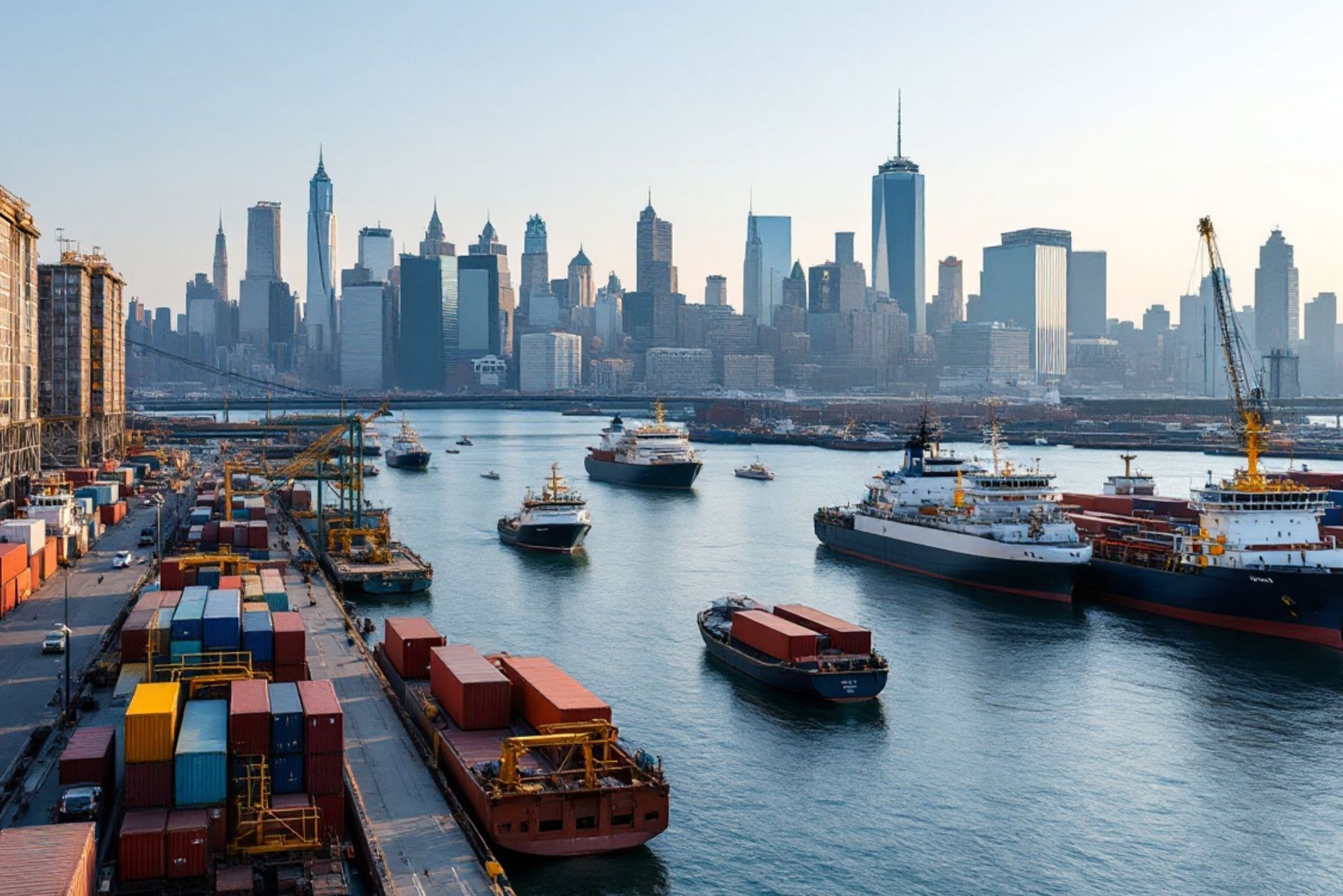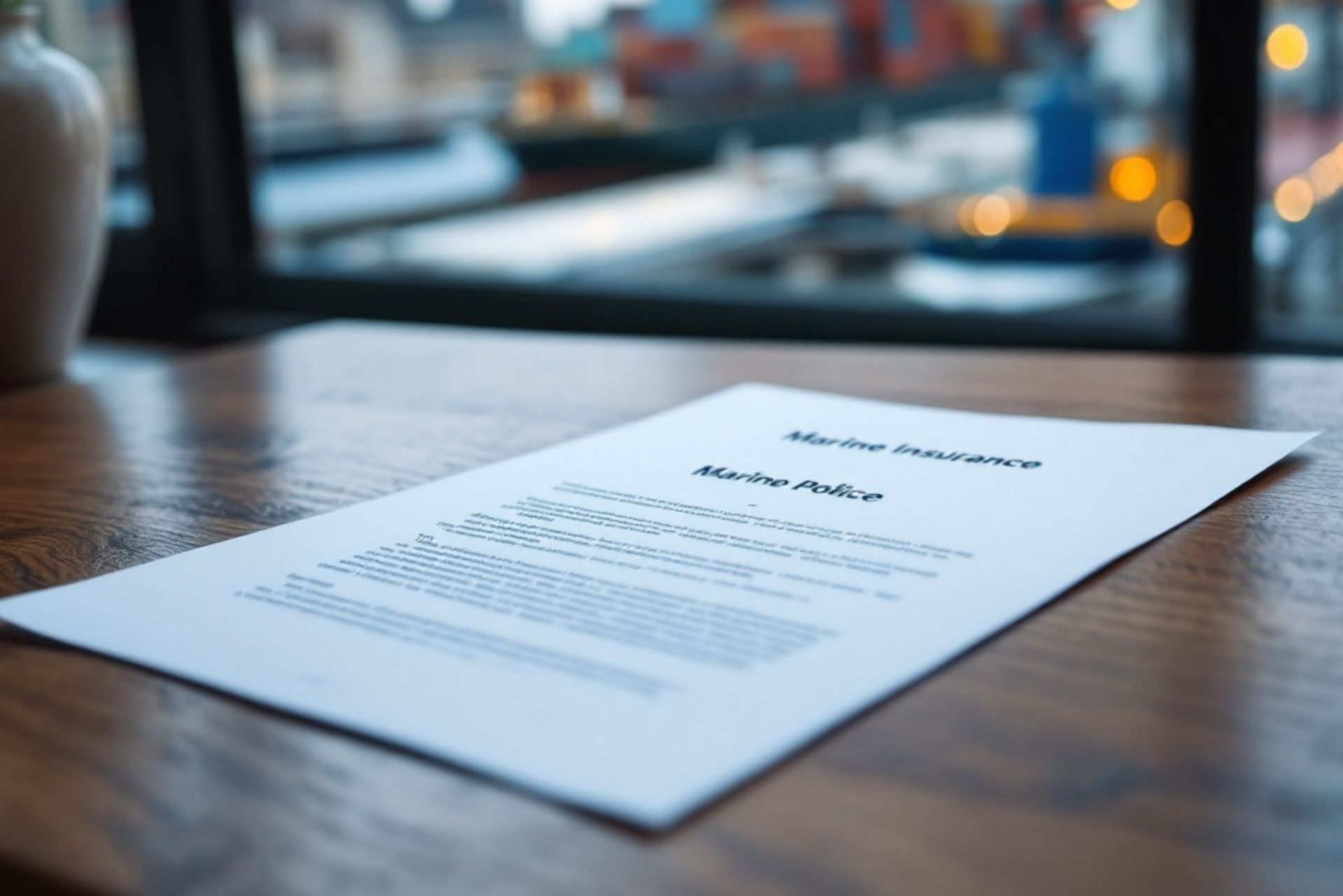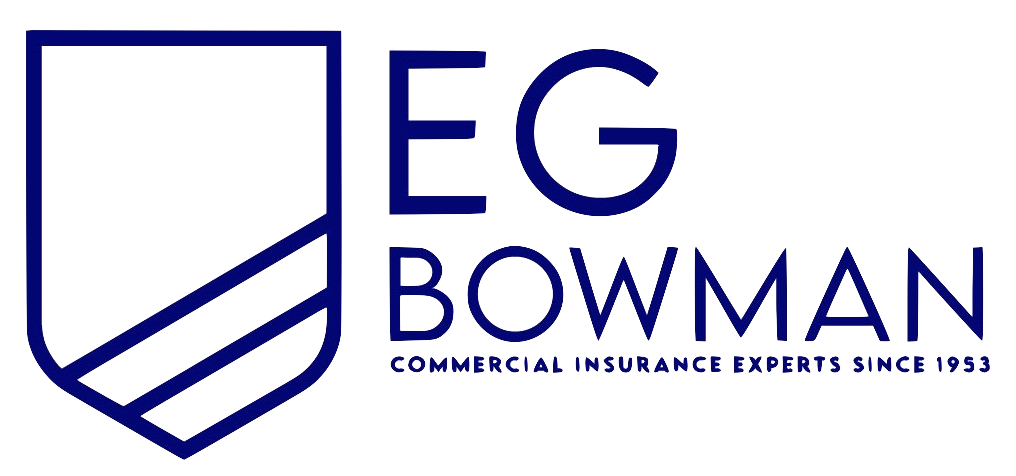
Most Common Business Policies
Index
Contact Us
Inland marine insurance is a vital component of the insurance industry, playing a crucial role in protecting goods and transportation. This article will provide a comprehensive overview of inland marine insurance in New York, covering essential aspects from definitions and policies to claims processes and costs. Whether you're a seasoned business owner or new to the concept, understanding inland marine insurance is necessary for safeguarding your assets.
Understanding Inland Marine Insurance
Definition and Importance of Inland Marine Insurance
Inland marine insurance originated from ocean marine insurance policies that were designed to protect ships and cargo on water. Today, it has evolved to cover a wide range of goods in transit, including items moving overland by truck or rail, and even those stored at a location that is not fixed, such as trailers and mobile equipment.
The importance of inland marine insurance lies in its ability to provide specialized coverage for items that may not be covered adequately under standard property insurance policies. Businesses that deal with valuable or high-risk goods often benefit from this type of insurance, as it ensures they are financially protected against damage, theft, or loss. For instance, a construction company transporting expensive machinery to a job site can face significant financial repercussions if that equipment is damaged during transit. Inland marine insurance mitigates these risks, allowing businesses to operate with greater confidence.
Moreover, the evolving nature of commerce, especially with the rise of e-commerce and just-in-time delivery systems, has made inland marine insurance even more relevant. Companies are increasingly relying on third-party logistics providers to transport goods, which can introduce additional risks. Having a robust inland marine insurance policy can safeguard against potential liabilities that arise from these complex supply chains, ensuring that businesses can maintain their operations without interruption.
Key Features of Inland Marine Insurance
Some key features of inland marine insurance include:
- Coverage for unique items: Unlike standard policies, inland marine insurance can be tailored to cover items like art, antiques, equipment, and other valuables that require specific attention.
- Protection during transit: This insurance provides coverage for goods while they are being transported, whether on land or water, ensuring peace of mind for businesses.
- Flexible policy options: Inland marine insurance allows for customization of policies to fit the specific needs of different industries and businesses.
Understanding these features is essential for business owners in New York who rely heavily on transportation and storage of valuable goods. Additionally, the ability to include coverage for items in transit can be particularly beneficial for businesses involved in trade shows or exhibitions, where valuable displays and equipment are frequently moved. This adaptability not only protects the assets but also enhances the overall operational efficiency of businesses that depend on the mobility of their goods.
Furthermore, inland marine insurance can also cover specialized risks associated with certain industries. For example, in the technology sector, companies may need coverage for electronic equipment that is frequently transported between locations. Similarly, the construction industry often requires coverage for tools and machinery that are moved from one job site to another. By understanding the nuances of inland marine insurance, business owners can better navigate their unique risks and ensure that their investments are adequately protected.

New York Inland Marine Insurance Policies
Types of Policies Available
In New York, there are several types of inland marine insurance policies available to businesses. These include:
- Transport Insurance: This type covers goods while they are being transported by land, sea, or air. It is particularly beneficial for businesses that rely heavily on logistics and shipping, as it ensures that their products are protected throughout the entire journey, from warehouse to customer.
- Bailee's Customer Insurance: This policy protects the property of others that a business is responsible for during service or repair. For instance, a dry cleaner or repair shop can safeguard themselves against potential claims if a customer's item is damaged while in their possession.
- Equipment Insurance: This policy covers specialized equipment used in various industries, ensuring against losses from theft or damage. Businesses that utilize expensive machinery, such as construction firms or medical facilities, find this coverage essential to maintain their operations without significant financial setbacks.
- Floaters: These are specific policies that cover items that are frequently moved or not confined to a single location. This is ideal for businesses that deal with inventory that is constantly on the move, such as art galleries or rental services.
By understanding the types of policies available, business owners can select the most appropriate coverage for their operations. Additionally, consulting with an insurance professional can provide insights into tailored solutions that meet specific business needs, ensuring comprehensive protection against potential risks.
Coverage and Exclusions
Inland marine insurance policies typically cover a wide range of incidents, including theft, fire, and accidental damage. However, it’s crucial to read the fine print, as specific exclusions may apply. Common exclusions include:
- Loss due to war or rebellion.
- Damage due to natural disasters, unless specifically covered.
- Maintaining and repairing property, which is often the responsibility of the policyholder.
Understanding what is covered and what is not helps businesses to manage risks effectively and prevents unexpected financial burdens. Furthermore, it is advisable for business owners to regularly review their policies and update them as their operations evolve. This proactive approach ensures that they are not left vulnerable to new risks that may arise as their business grows or changes, such as the introduction of new products or expansion into different markets.
Moreover, businesses should also consider the importance of maintaining accurate records of their inventory and equipment. This not only aids in the claims process should an incident occur but also helps in evaluating the adequacy of their coverage. Keeping detailed documentation can streamline communication with insurers and facilitate a smoother claims experience, ultimately leading to better financial stability in times of crisis.
The Process of Acquiring Inland Marine Insurance in New York
Steps to Apply for Inland Marine Insurance
Acquiring inland marine insurance in New York generally involves several steps:
- Assess Your Needs: Evaluate the specifics of your business to determine what items or goods require coverage.
- Research Insurance Providers: Investigate various companies that offer inland marine insurance, focusing on their reputation and customer service.
- Request Quotes: Contact multiple insurers to gather quotes and understand different coverage options.
- Review Policies: Compare policy details, including coverage limits and exclusions, before making a decision.
- Finalize Your Policy: Once you select an insurer, you will complete the necessary paperwork and arrange for payment.
Following these steps can streamline the acquisition process and ensure you find the best coverage for your business needs. Additionally, it is wise to keep detailed records of your assets, as this will not only assist in the assessment phase but also provide clarity when discussing coverage options with insurers. Having an organized inventory can help you identify any gaps in coverage, ensuring that all valuable items are adequately protected.
Understanding the Terms and Conditions
Every inland marine insurance policy comes with specific terms and conditions that outline the rights and obligations of both the insurer and the insured. Understanding these terms is crucial to ensure compliance and proper understanding of coverage.
Key components often included in the policy are:
- Coverage Limits: The maximum amount the insurer will pay in the event of a claim.
- Deductibles: The amount the policyholder must pay out-of-pocket before the insurance coverage kicks in.
- Policy Duration: The time frame during which coverage is valid.
Carefully reviewing these elements helps policyholders avoid surprises during claims processing. Furthermore, it is essential to pay attention to any endorsements or riders that may be attached to the policy, as these can modify the standard terms and provide additional coverage tailored to specific needs. For instance, if your business frequently transports high-value items, you might consider adding a rider that increases your coverage limits for those particular goods, ensuring that you are fully protected against potential risks.
Cost of Inland Marine Insurance in New York
Factors Influencing the Cost
The cost of inland marine insurance in New York can vary significantly based on several factors, including:
- Type of Goods Insured: Higher value or risk items generally result in higher premiums.
- Business Size: Larger businesses may have more extensive coverage needs, affecting the overall cost.
- Claims History: A history of frequent claims can lead to increased insurance costs.
Understanding how these factors influence premiums can help business owners manage their insurance budgets more effectively. Additionally, the nature of the goods being transported plays a crucial role in determining risk. For instance, perishable items, such as food products, may require more specialized coverage due to their susceptibility to damage during transit. Similarly, high-value electronics or fine art may necessitate additional endorsements to ensure full protection against theft or loss. Therefore, it is essential for businesses to accurately assess the value and nature of their goods to secure appropriate coverage.
Tips to Lower Your Insurance Premium
Several strategies can help you reduce your inland marine insurance premium:
- Bundle Policies: Consider bundling your inland marine coverage with other insurance policies to receive a multi-policy discount.
- Increase Deductibles: Opting for a higher deductible can lower premiums, but remember to ensure you can afford out-of-pocket costs in case of a claim.
- Improve Security Measures: Investing in better security and risk management can decrease insurance costs over time.
Employing these strategies can ultimately lead to significant savings on insurance premiums. Furthermore, conducting regular reviews of your insurance needs and coverage can also be beneficial. As your business evolves, so too may your insurance requirements. Engaging with an insurance advisor who specializes in inland marine policies can provide insights into potential gaps in coverage and help identify additional ways to save. Additionally, participating in risk management training or workshops can further enhance your understanding of best practices, potentially leading to lower premiums due to reduced risk exposure.

Filing a Claim with Your Inland Marine Insurance
When and How to File a Claim
Filing a claim should be done as soon as possible after an incident. Key steps include:
- Notify Your Insurer: Contact your insurance company to report the loss or damage.
- Document the Incident: Collect evidence such as photographs, receipts, and witness statements to support your claim.
- Complete Required Forms: Fill out any necessary claim forms provided by your insurer accurately and completely.
Timeliness and thoroughness are crucial when filing a claim, as they can significantly affect the outcome. It is also advisable to keep a detailed record of all communications with your insurer, including dates, times, and the names of representatives you speak with. This documentation can be invaluable should any disputes arise regarding your claim.
Additionally, be aware of any specific time limits for filing claims as stipulated in your policy. Some insurers may require claims to be filed within a certain number of days following an incident, so understanding your policy's terms is essential to ensure your claim is accepted without complications.
What to Expect After Filing a Claim
After filing a claim, you can expect the following process:
- Your insurer will review the claim for validity and gather additional information if necessary.
- Adjusters may be dispatched to assess the damage or loss before approving the claim.
- You will be informed of the claim decision and, if approved, the amount to be compensated.
Filing and following up on claims can sometimes be a lengthy process, so maintaining
communication with your insurer is essential. It's important to stay proactive during this period; check in regularly to ensure your claim is being processed and to address any questions or concerns that may arise. This vigilance can help expedite the process and keep you informed about the status of your claim.
Moreover, be prepared for the possibility of negotiations regarding the settlement amount. Insurers may initially offer a lower compensation than expected, so having your documentation ready to justify your claim can be crucial. Understanding the value of your insured items and being able to articulate that value can lead to a more favorable outcome in the claims process.
Frequently Asked Questions about Inland Marine Insurance in New York
Common Misconceptions and Clarifications
Many misconceptions surround inland marine insurance. Some common myths include:
- It only covers maritime activities: Inland marine insurance covers a wide scope, including overland transport and storage of goods.
- It's only for large businesses: Small businesses and individual owners can benefit from inland marine insurance as well.
Clearing these misconceptions allows potential policyholders to better understand the utility and scope of coverage available. For instance, many people are surprised to learn that inland marine insurance can also protect equipment and tools that are frequently transported from one job site to another, making it an essential policy for contractors and tradespeople. Additionally, coverage can extend to valuable items such as fine art, jewelry, and collectibles, which may not be adequately protected under standard property insurance policies.
Expert Advice for First-Time Policyholders
For first-time policyholders, it is advisable to:
- Seek expert advice: Consulting with an insurance broker can provide personalized guidance based on unique business needs.
- Read all policy documents: Thoroughly review all materials to ensure full understanding before committing.
- Ask questions: Do not hesitate to raise any questions or concerns to clarify terms and coverage options.
Taking these steps can ensure a smoother transition into acquiring inland marine insurance, aiding in making well-informed decisions. Additionally, first-time policyholders should consider evaluating their specific risks and the types of goods they transport or store. This evaluation will help in selecting the most appropriate coverage limits and endorsements, ensuring that all potential vulnerabilities are addressed. Furthermore, it can be beneficial to keep detailed records of items covered under the policy, including photographs and appraisals, to facilitate the claims process should the need arise.
In conclusion, understanding inland marine insurance is crucial for businesses in New York that require specialized coverage for their valuable goods. By familiarizing themselves with the features, policies, claims process, and costs associated with this insurance type, business owners can make informed decisions to protect their assets effectively.
